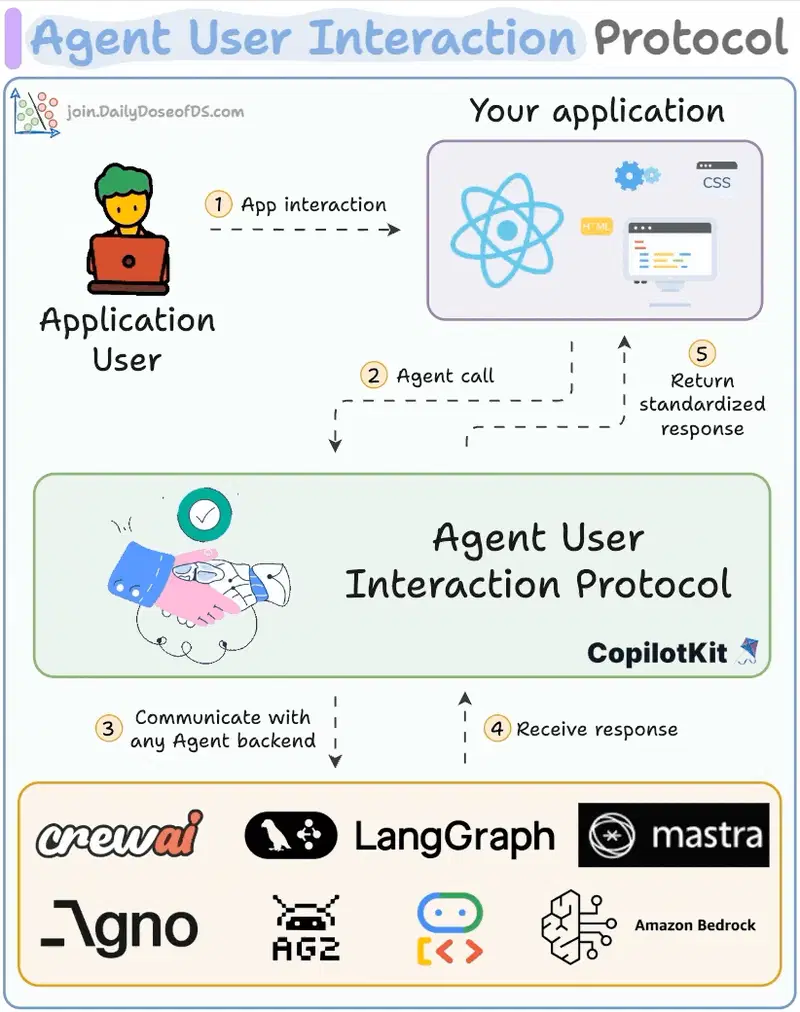I'm thrilled to announce AG-UI, the Agent-User Interaction Protocol, a streamlined bridge connecting AI agents to real-world applications.
This brand new protocol is brought to you by CopilotKit
What is AG-UI?
AG-UI is an open, lightweight protocol that streams a single sequence of JSON events over standard HTTP or an optional binary channel. These events—messages, tool calls, state patches, lifecycle signals—flow seamlessly between your agent backend and front-end interface, maintaining perfect real-time synchronization.
Get started in minutes using our TypeScript or Python SDK with any agent backend (OpenAI, Ollama, LangGraph, or custom code). Visit docs.ag-ui.com for the specification, quick-start guide, and interactive playground.
Agent-User Interaction
Today’s AI Agent ecosystem is maturing. Agents are going from interesting viral demos to actual production use, including by some of the biggest enterprises in the world.
However, the ecosystem has largely focused on backend automation, processes that run independently with limited user interaction. Workflows that are set off, or happen automatically, whose output is then used.
Common use-cases include data migration, research and summarization, form-filling, etc.
Repeatable and simple workflows, where accuracy can be ensured, or where 80% accuracy is good enough.
These have already been big productivity boosters. Automating time-consuming and tedious tasks.
Where Agents Meet Users
Coding tools (Devin vs. Cursor)
Throughout the adoption of generative AI, coding tools have been canneries in the coal mine, and Cursor is the best example of a user-interactive agent. An AI agent that works alongside users, in a shared workspace.
This contrasts with Devin, which was the promise of a fully autonomous agent that automates high-level work.
For many of the most important use-cases, Agents are helpful if they can work alongside users. This means users can see what the agent is doing, can co-work on the same output, and easily iterate together in a shared workspace.
The Challenges of Building a User-Interactive Agent
Creating these collaborative experiences presents significant technical challenges:
Real-time streaming: LLMs produce tokens incrementally; UIs need them instantly without blocking on the full response.
Tool orchestration: Modern agents call functions, run code, hit APIs. The UI must show progress and results, sometimes ask for human approval, and then resume the run—all without losing context.
Shared mutable state: Agents often generate plans, tables, or code folders that evolve step-by-step. Shipping entire blobs each time wastes bandwidth; sending diffs demands a clear schema.
Concurrency & cancellation: A user might fire off multiple queries, stop one mid-flight, or switch threads. The backend and front-end need thread IDs, run IDs, and an orderly shutdown path.
Security boundaries: Streaming arbitrary data over WebSockets is easy until you need CORS, auth tokens, and audit logs that an enterprise will sign off on.
Framework sprawl: LangChain, CrewAI, Mastra, AG2, home-grown scripts—all speak slightly different dialects. Without a standard, every UI must reinvent adapters and edge-case handling.
The AG-UI Solution
AG-UI addresses these challenges through a simple yet powerful approach:
Your client makes a single POST to the agent endpoint, then listens to a unified event stream. Each event has a type(e.g., TEXT_MESSAGE_CONTENT, TOOL_CALL_START, STATE_DELTA), and minimal payload. Agents emit events as they occur, and UIs respond appropriately—displaying partial text, rendering visualizations when tools complete, or updating interfaces when state changes.
Built on standard HTTP, AG-UI integrates smoothly with existing infrastructure while offering an optional binary serializer for performance-critical applications.
What This Enables
AG-UI establishes a consistent contract between agents and interfaces, eliminating custom WebSocket formats and text parsing hacks. With this unified protocol:
Components become interchangeable: Use CopilotKit's React components with any AG-UI source
Backend flexibility: Switch between cloud and local models without UI changes
Multi-agent coordination: Orchestrate specialized agents through a single interface
Enhanced development: Build faster with richer experiences and zero vendor lock-in
AG-UI isn't just a technical specification—it's the foundation for the next generation of AI-enhanced applications where humans and agents seamlessly collaborate.
Please check out the Getting Started docs, and I look forward to you trying it out.
Interested in connecting with other AI developers?
Join the AG-UI Discord and join the AI developer community: https://go.copilotkit.ai/AG-UI-Discord
Follow CopilotKit on Twitter and say hi, and if you'd like to build something cool.




















Crazy things are happening right now. Really awesome work by the team! 🙌